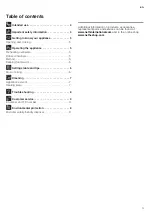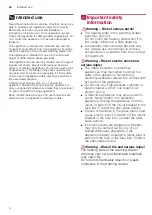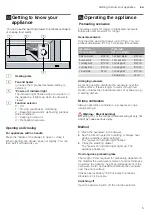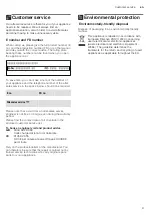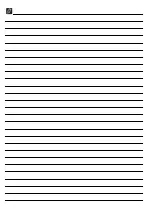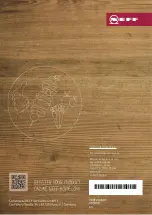
en
Settings table and tips
6
Removing ovenware
Remove ovenware from the drawer using oven gloves
or an oven cloth.
:
Warning – Risk of burning!
The upper surface of the heating plate will be hot. The
base of the ovenware will be hotter than the top.
Keeping food warm
Do not place hot saucepans or pans on the glass
surface of the warming drawer immediately after
removing them from the hot drawer. This could damage
the glass surface.
Do not fill the ovenware to such an extent that food
spills over.
Cover the food with a heat-resistant lid or aluminium foil.
It is recommended that you do not keep food warm for
longer than an hour.
Suitable foods:
The appliance is suitable for keeping
meat, poultry, fish, sauces, vegetables, side dishes and
soups warm.
Method
1.
Place the ovenware in the drawer.
2.
Set the function selector to setting 3
and preheat the
appliance for 10
minutes.
3.
Add the food to the preheated ovenware.
4.
Close the drawer again.
The "power on" indicator light lights up. The
appliance heats up.
Switching off
Switch off the function selector. Remove the food from
the drawer using oven gloves or an oven cloth.
Slow cooking
Slow cooking is the ideal cooking method for all tender
pieces of meat which are to be cooked rare or very
rare. The meat remains very juicy and turns out as soft
as butter. Advantage: this gives you flexibility when
planning meals, since the cooking times for slow
cooking are generally longer. Slow-cooked meat can be
kept warm easily.
Suitable ovenware:
Use ovenware made out of glass,
porcelain or ceramic and with a lid, e.g. a glass roasting
dish.
Method
1.
Preheat the warming drawer containing the
ovenware at setting 4.
2.
Rapidly heat a little fat in a pan. Sear the meat over a
high heat and then place it directly in the warmed
ovenware. Place the lid on top.
3.
Put the ovenware with the meat back in the warning
drawer and complete the cooking. Set the function
selector to setting 3.
Notes on slow cooking
Only use high-quality, fresh meat for this. Carefully
remove sinews and fat. Fat develops a strong, distinct
taste during slow cooking.
The meat should not be turned even if it is a large joint.
You can cut the meat immediately after slow cooking. It
is not necessary to leave the meat to stand.
This particular cooking method always leaves the inside
of the meat medium rare. However, this does not mean
that it is raw or not properly cooked.
Meat that has been slow-cooked is not as hot as meat
that has been cooked conventionally. Serve the sauce
very hot. Place the plates in the warming drawer for the
last 20-30 minutes.
Level
Food/crockery
Note
1
Thawing delicate frozen foods, e.g. cream cakes, butter, sausages,
cheese
thaw
1
Proving (covering) yeast dough
cover
2
Thawing frozen foods, e.g. meat, cakes, bread
thaw
2
Keeping eggs warm, e.g. cooked eggs, scrambled eggs
Preheating crockery, covering food
2
Keeping bread warm, e.g. toast, rolls
Preheating crockery, covering food
2
Preheating cups and glasses
e.g. espresso cups
2
Delicate foods, e.g. cooked meat
Covering crockery
3
Keeping food warm
Preheating crockery, covering food
3
Keeping drinks warm
Preheating crockery, covering drinks
3
Keeping flatbreads warm, e.g. pancakes, wraps, tacos
Preheating crockery, covering food
3
Keeping cakes warm, e.g. crumbles, muffins
Preheating crockery, covering food
3
Melting blocks of chocolate or couverture chocolate
Preheating crockery, reducing liquids
3
Melting gelatin
Open, approx. 20
minutes
4
Preheating crockery
Not suitable for cups and glasses
Содержание N17HH1 0 Series
Страница 1: ...en INSTRUCTION MANUAL WARMING DRAWER N17HH1 0 N17HH2 0 N17HH 0...
Страница 2: ......
Страница 10: ...6...
Страница 11: ...6...



